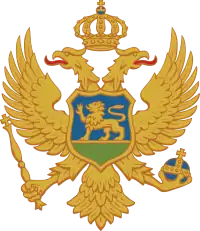Elections in Montenegro
Montenegro holds national election for the Parliament and the office of President. Montenegro has a multi-party system with numerous parties. The Parliament has 81 members elected by a system of proportional representation using D'Hondt method for a four-year term. To enter the Parliament, parties have to surpass the electoral threshold of 3%. The President of Montenegro is elected at large, with a second round runoff between the two first placed candidates, if no candidate receives an absolute majority in the first round.
 |
|---|
| This article is part of a series on the politics and government of Montenegro |
| Constitution |
Latest elections
2020 Parliamentary election
| Party | Votes | % | Seats | +/– | |
|---|---|---|---|---|---|
| Democratic Party of Socialists | 143,548 | 35.06 | 30 | –6 | |
| For the Future of Montenegro | 133,267 | 32.55 | 27 | +6 | |
| Peace is Our Nation | 51,297 | 12.54 | 10 | –2 | |
| United Reform Action | 22,649 | 5.53 | 4 | +2 | |
| Social Democrats | 16,769 | 4.10 | 3 | +1 | |
| Bosniak PartyM | 16,286 | 3.98 | 3 | +1 | |
| Social Democratic Party | 12,839 | 3.14 | 2 | –2 | |
| Albanian ListM | 6,488 | 1.58 | 1 | 0 | |
| Albanian CoalitionM | 4,675 | 1.14 | 1 | +1 | |
| Croatian Civic InitiativeM | 1,115 | 0.27 | 0 | –1 | |
| Croatian Reform PartyM | 532 | 0.13 | 0 | New | |
| Invalid/blank votes | 4,503 | 2.09 | – | – | |
| Total | 413,954 | 100 | 81 | 0 | |
| Registered voters/turnout | 541,232 | 76.65 | – | – | |
| M — denotes the national minority lists, for which the 3% threshold does not apply. | |||||
2018 Presidential elections
| Candidate | Party | Votes | % | |
|---|---|---|---|---|
| Milo Đukanović | Democratic Party of Socialists | 180,274 | 53.90 | |
| Mladen Bojanić | Independent | 111,711 | 33.40 | |
| Draginja Vuksanović | Social Democratic Party | 27,441 | 8.20 | |
| Marko Milačić | True Montenegro | 9,405 | 2.81 | |
| Hazbija Kalač | Justice and Reconciliation Party | 2,677 | 0.80 | |
| Vasilije Miličković | Independent | 1,593 | 0.48 | |
| Dobrilo Dedeić | Serb Coalition | 1,363 | 0.41 | |
| Invalid/blank votes | 5,998 | – | ||
| Total | 340,462 | 100 | ||
| Registered voters/turnout | 532,599 | 63.92 | ||
| Source: DIK | ||||
See also
External links
This article is issued from Wikipedia. The text is licensed under Creative Commons - Attribution - Sharealike. Additional terms may apply for the media files.